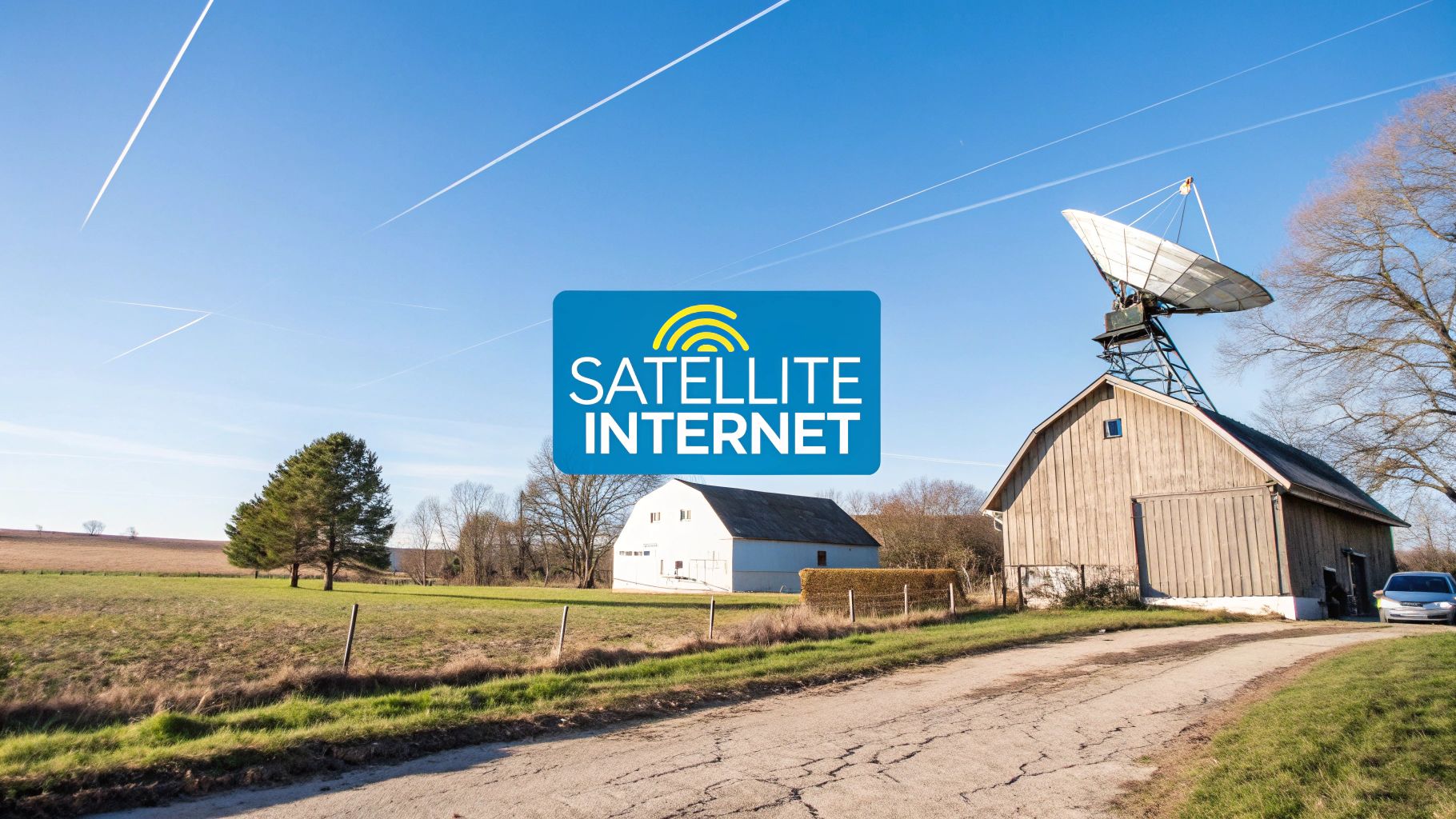

· By James
satellite internet rural areas: A Complete Guide
For so many folks living outside the city, fast and reliable internet has always felt just out of reach. That's changing. Satellite internet for rural areas is finally delivering on the promise of high-speed connectivity, beaming it directly from space and completely skipping the need for buried cables. This isn't just a minor upgrade; it's a genuine lifeline that's closing the digital divide for work, school, and even just relaxing with a movie.
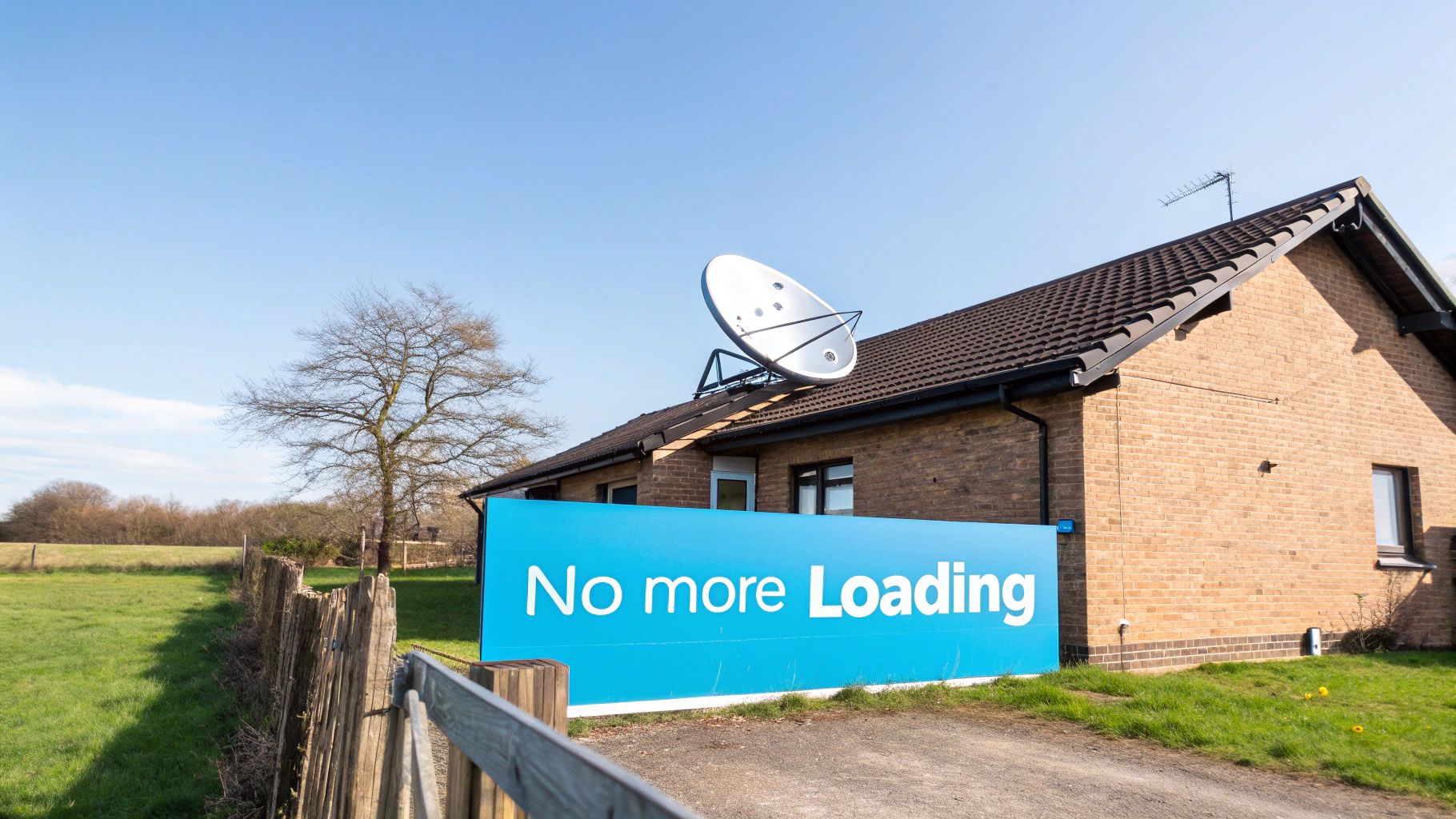
The End of Slow Internet for Rural Homes
We've all known the frustration of a buffering wheel, but for a lot of people in rural America, it’s a daily headache. Old-school options like DSL or dial-up just can't handle what we need to do online today, and it's easy to feel left behind.
This is where satellite internet completely changes the game. Think of it like a powerful, dedicated Wi-Fi signal broadcast from orbit straight to a small dish on your roof. It neatly sidesteps the whole issue of running miles of expensive and often nonexistent fiber or cable lines.
A New Era of Rural Connectivity
This isn't your parents' satellite internet. It's no longer just the "last resort" option it once was. Thanks to huge leaps in technology—especially the launch of thousands of Low Earth Orbit (LEO) satellites—performance has skyrocketed. These newer systems deliver much faster speeds and lower latency, making things that used to be impossible part of your daily routine.
Suddenly, you can actually:
- Work from home without your video call freezing mid-sentence.
- Take online classes without the lecture buffering every two minutes.
- Stream movies in HD without the constant starts and stops.
- Video chat with family and feel like you're right there with them.
Satellite internet is no longer just an alternative. For many rural homes, it’s now a superior high-speed connection that lets you live and work without compromise, no matter where you are on the map.
Bypassing Ground-Based Limitations
The single biggest advantage of satellite internet is its reach. The logistics and costs of digging trenches and laying physical cable to serve just a few spread-out homes are staggering. Satellite tech elegantly hops over that entire problem.
If your home has a clear view of the sky, you can get a signal. It's that simple. This fundamental difference is what makes it a true game-changer. For a deeper dive into the different ways to get online, check out our guide on internet access for rural areas. It’s about more than just getting connected; it’s about unlocking the same opportunities people have in the city.
How Satellite Technology Delivers High Speed Internet
Have you ever wondered how you can stream a movie in the middle of nowhere? How that signal travels thousands of miles into space and back to your screen in a blink? Satellite internet might seem like science fiction, but the core concept is surprisingly straightforward. It completely cuts out the need for physical cables, creating a direct wireless link between your home and an orbiting satellite.
The whole trip starts the second you click a link. Your request zips from your computer to a small dish on your property, which then beams that signal up to a satellite. That satellite immediately relays the signal down to a ground station (often called a "gateway") that's plugged into the global internet. The process reverses in an instant, shooting the data you requested right back to you.
The Old Way Versus The New Way
Here's the thing, though: not all satellite internet is created equal. The biggest difference—and the one that really matters for anyone looking for good satellite internet in rural areas—is how far away those satellites are.
For years, the only option was Geostationary (GEO) satellites. These things are parked way out there, about 22,000 miles away, in a fixed spot above the Earth. That massive distance creates a noticeable time delay, which we call latency.
Think of it like shouting across a vast canyon and waiting for the echo. That delay is latency, and it's the reason older satellite internet was notoriously bad for anything happening in real-time, like a video call or an online game.
LEO Satellites Are a Game Changer
Today’s modern systems use Low Earth Orbit (LEO) satellites, and they’ve completely changed the game. These satellites are much, much closer, zipping around between 300 and 1,200 miles above us. Being so close drastically cuts down the signal's travel time, giving you a connection that feels fast and responsive.
This isn't just a small tweak; it's a massive leap forward. LEO technology has quickly become one of the most important tools for closing the digital divide in places where laying fiber is just not an option. In fact, the global satellite internet market is already valued at roughly USD 10.4 billion in 2024 and is expected to more than double by 2030. That boom is almost entirely thanks to these powerful new LEO networks. You can read more on these trends in a detailed Grand View Research report.
The difference between GEO and LEO is like having a face-to-face conversation versus waiting for a letter to cross the country. With LEO, the connection is snappy and immediate, making it a perfect fit for the demands of modern online life. For a deeper dive into how it all comes together, check out our guide on how satellite internet works.
Choosing Your Rural Satellite Internet Provider
Alright, so you’ve decided satellite internet is the answer for your rural spot. That's the first hurdle cleared. Now comes the fun part: picking the company that’ll actually beam that internet down to you.
This might feel like a big decision, and it is, but it really boils down to your daily habits. What you do online day-in and day-out will point you to the right provider. It's not just about finding the cheapest plan; it's about matching the technology to your lifestyle. The biggest fork in the road is the type of satellite system a provider uses—the older Geostationary (GEO) tech versus the newer Low Earth Orbit (LEO) constellations. This one choice affects everything from whether your Zoom calls are choppy to how long you stare at a buffering wheel.
Comparing the Key Players
Let's put the big three—Starlink, Viasat, and HughesNet—side-by-side to see what makes them tick. Each one takes a different path to delivering satellite internet to rural areas, and that directly shapes the speed, data, and responsiveness you'll experience.
-
Starlink (LEO): As the leading LEO provider, Starlink is a game-changer for rural internet. The low-latency connection makes it a beast for things that used to be a satellite-user's nightmare: competitive online gaming, smooth video conferences for remote work, and streaming 4K movies without a hiccup.
-
Viasat & HughesNet (GEO): These guys are the veterans, using traditional GEO satellites. They get points for covering just about everywhere, but the immense distance their signals have to travel creates noticeable lag (latency). They're perfectly fine for basic web browsing, checking emails, and standard-definition streaming, but they can struggle with real-time, interactive stuff.
This infographic does a great job of showing why that LEO vs. GEO distinction matters so much.
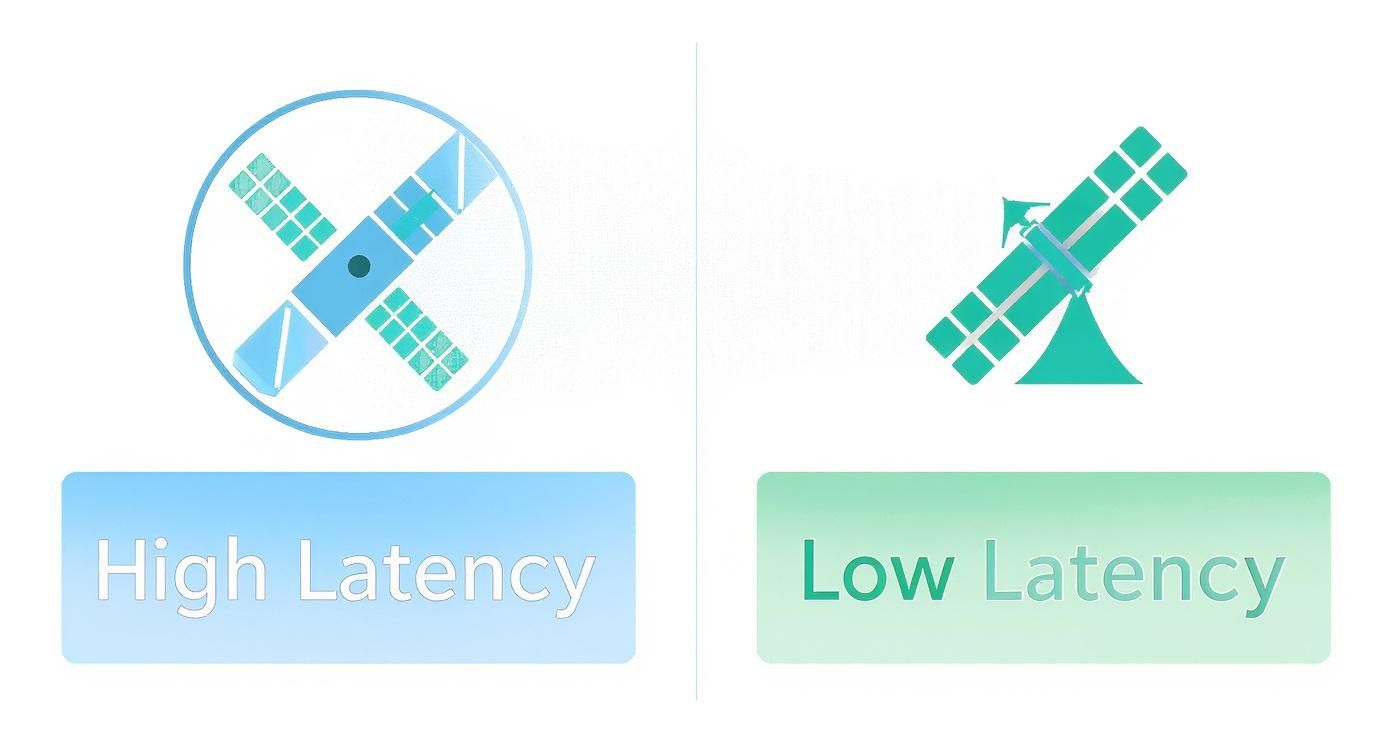
You can see how LEO’s closer orbit makes for a much zippier, more responsive connection. That huge gap with GEO satellites is where the frustrating lag comes from.
To help you visualize the differences, here's a quick comparison of the leading providers.
Satellite Internet Provider Feature Comparison
| Provider | Technology Type | Typical Download Speed | Best For |
|---|---|---|---|
| Starlink | Low Earth Orbit (LEO) | 50 - 220 Mbps | High-demand users: remote work, 4K streaming, online gaming. |
| Viasat | Geostationary (GEO) | Up to 100 Mbps | Moderate users: general browsing, SD/HD streaming, social media. |
| HughesNet | Geostationary (GEO) | 25 - 50 Mbps | Light users: email, basic web surfing, occasional SD streaming. |
This table lays out the core trade-offs: LEO offers a massive performance boost for those who need it, while GEO providers can be a solid, more established choice for less demanding internet use.
Speeds and Data Policies
Your online life dictates how much speed and data you really need. A family with a remote worker, a student, and a Netflix enthusiast has way different demands than a couple who just wants to check the news and email the grandkids.
LEO providers are rewriting the rulebook on speed. Starlink, for instance, is bringing download speeds between 50 Mbps and over 200 Mbps to rural homes. That's a world away from what was previously possible. Traditional providers like HughesNet and Viasat, who serve hundreds of thousands of rural North Americans, typically offer speeds in the 12 to 100 Mbps range. The performance gap is pretty clear if you look into the global rural internet system market.
When you're shopping around, be sure to ask pointed questions about data policies. Many plans have data caps. If you go over, you could get "throttled," which is a nice way of saying they'll slow your connection to a crawl for the rest of the month.
Making the Right Decision for You
So, how do you choose? It all comes back to being honest about your internet usage.
- For the Power User: If your household is full of heavy internet users—you work from home, game online, or have multiple people streaming at once—a LEO provider like Starlink is almost certainly the way to go. The low latency and high speeds are built for this.
- For Basic Use: If your needs are more modest—browsing websites, scrolling social media, and watching a movie in standard definition now and then—a GEO provider like Viasat or HughesNet might be the more practical and budget-friendly option.
Take a minute to think about your family's daily and weekly internet habits. Once you have a clear picture of what you actually do online, you can confidently pick a provider that gives you the performance you need without overpaying for speed you’ll never use.
The Reality of Using Satellite Internet Daily
Making the switch to satellite internet can feel like a game-changer, especially if you've been putting up with painfully slow connections for years. For the first time, folks in out-of-the-way places can tap into speeds that actually compete with what you’d find in the city. But to really know if it's the right move for you, it's worth looking at the whole picture—the incredible upsides and the practical, day-to-day trade-offs.
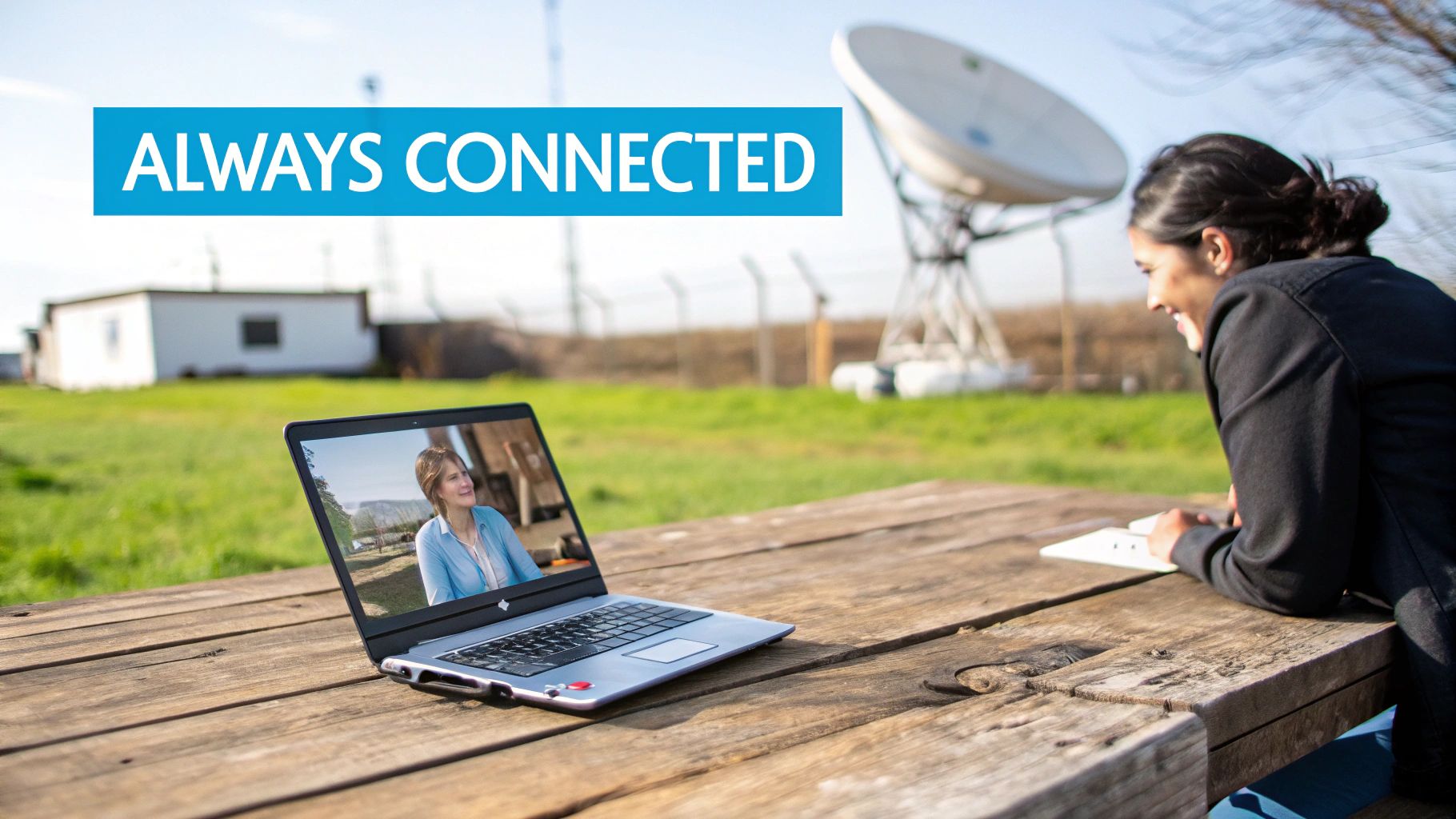
The biggest win is simple: availability. If you can see the sky, you can get online. This single fact makes satellite internet in rural areas a lifesaver, neatly sidestepping the massive expense and logistical headaches of running physical cables to remote homes. Newer LEO systems, in particular, are now delivering the fast speeds and low latency needed for everything from work video calls to streaming your favorite shows in HD.
Navigating the Downsides
While the benefits are huge, there are a few real-world hurdles you'll want to think about before signing on the dotted line. Knowing them upfront means no unwelcome surprises later.
First off, the initial cost can be a bit of a shock. With traditional internet, you might get a free modem or pay a small rental fee. Satellite is different; you have to buy your own specialized gear. This one-time hardware cost for the dish, mount, and router can run several hundred dollars, so you'll need to factor that into your budget.
Then there's the weather. Satellite signals have a long journey, and sometimes, Mother Nature gets in the way.
This is something folks in the industry call "rain fade." It’s what happens when heavy rain, snow, or even really thick clouds temporarily mess with the signal. Modern systems are much better at handling it, but a truly nasty storm can still cause a slowdown or a brief outage.
Understanding Data Policies and Physical Limits
Finally, two other realities will shape your daily experience: how you manage your data and where you put the dish.
- Data Caps and Throttling: Some plans are unlimited, but many aren't. If you go over your monthly data allowance, your provider might "throttle" your connection, which is a nice way of saying they'll slow your speeds to a crawl for the rest of the month. This is a big deal if your family loves to stream movies or download big files.
- A Clear Line of Sight: Your satellite dish needs a wide-open, unobstructed view of the sky. Tall trees, a neighbor’s barn, or the angle of your roof can all block the signal. You have to be sure you have a good spot on your roof or property to mount the dish where it has a clear, constant link to the satellites above.
For most people, weighing these pros and cons is a straightforward process. The incredible advantage of having fast, reliable internet where it was never possible before easily outweighs the potential hiccups.
What to Expect for Costs and Installation
Alright, let's talk money. Getting set up with satellite internet isn't quite like signing up for cable or fiber where the equipment is often rented or thrown in for free. With satellite, you're looking at a pretty significant upfront investment for the hardware. This one-time cost gets you the dish, the modem or router, and all the mounting gear you need to get your home online.
This initial hardware fee is usually somewhere between $400 to over $600, though it can vary based on the provider and whatever promotions they have going. It's a big piece of the puzzle to consider when budgeting for satellite internet in rural areas. After that initial purchase, you’ll have your monthly subscription, which can run anywhere from $75 to $150 or more, depending on the speed and data you sign up for.
Breaking Down the Total Investment
It’s always a good idea to map out all the potential expenses so there are no surprises down the road. When you have a clear financial picture, you can make a decision you feel good about.
Here's what you can typically expect to pay:
- One-Time Hardware Kit: This is your ticket to entry. It covers the dish and the router, and it's non-negotiable.
- Monthly Service Plan: This is the ongoing cost for your internet access.
- Optional Installation Fee: Most of the newer kits are designed for a pretty simple DIY setup. But if you’re not a fan of ladders or just want a professional to handle it, you can pay for installation. This will likely add another $100 to $250 to your startup cost.
Before you pull the trigger, do yourself a favor and read the fine print in the service agreement. You'll want to pay close attention to things like contract lengths, what happens if you go over your data cap, and any fees for canceling early. Knowing this stuff upfront protects you from unexpected charges later on.
The Installation Process Explained
Once your kit arrives, the first job is to find the perfect spot for your dish. It needs a wide-open, clear view of the sky to lock onto the signal and keep it strong. Most companies provide a smartphone app that uses your phone's camera to help you scan the area and find the ideal location, making sure no trees or buildings get in the way.
The self-install process is surprisingly straightforward. You’ll mount the dish securely—maybe on your roof, a pole, or the side of the house—and then run a single cable from the dish inside to your router.
For those in truly remote spots where the power grid can be a bit shaky, looking into sustainable power solutions like solar panels can be a game-changer for keeping your internet running consistently. If you want a deeper dive, our complete guide to satellite internet for rural areas has even more helpful insights.
How Reliable Internet Is Transforming Rural Life
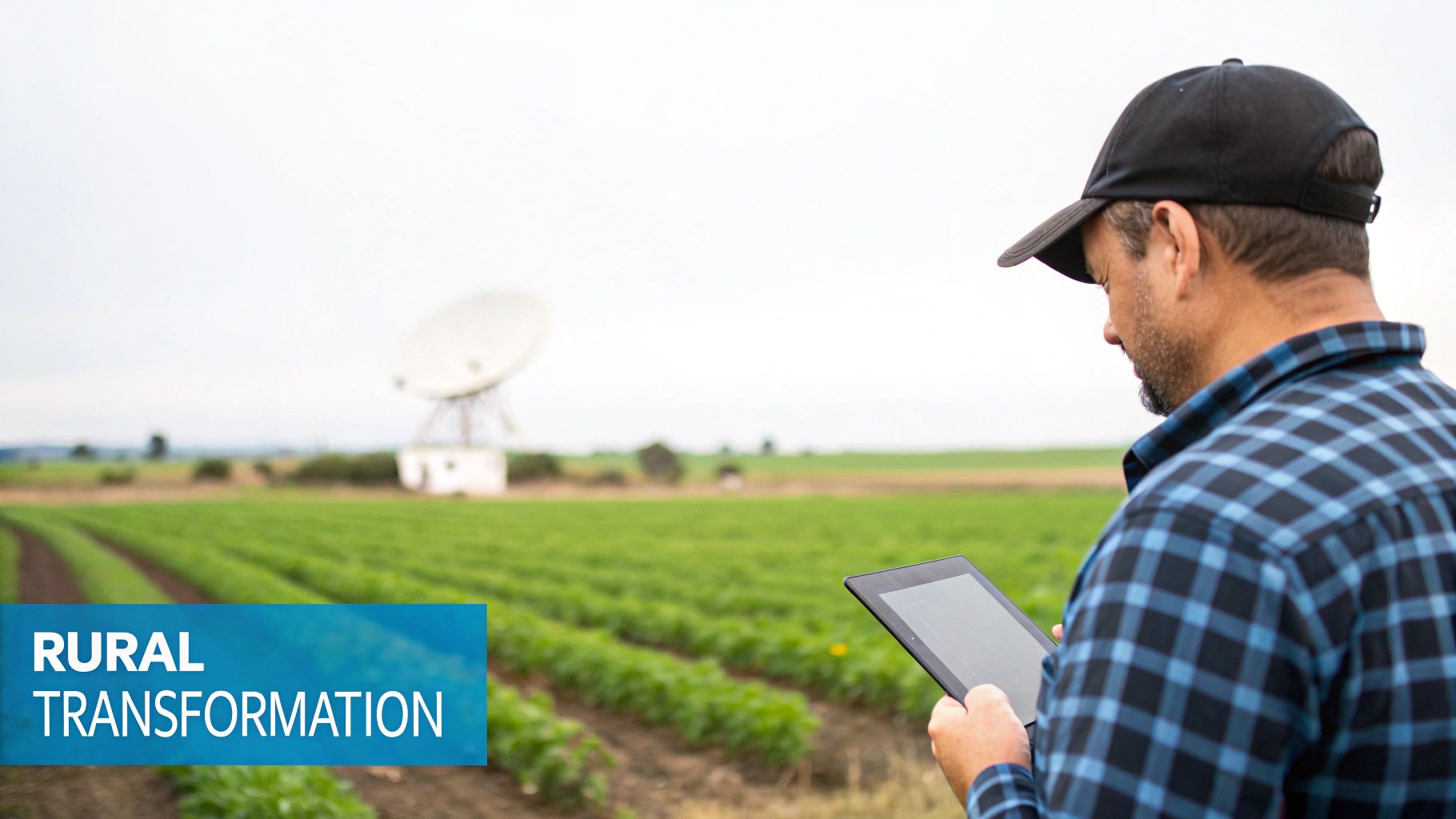
It's easy to get caught up in the hardware and subscription costs, but the real story of satellite internet in rural areas is the incredible impact it has on everyday life. High-speed, reliable internet isn't just another utility bill. It’s a bridge to opportunity, finally leveling the playing field between rural and urban communities.
This connection breathes new life into local economies and improves personal well-being. Suddenly, a small business in a quiet town can tap into a global customer base, and a student can access world-class education without ever leaving home.
Reliable internet access is a catalyst for economic growth and community development. It empowers local businesses, sparks new entrepreneurial ventures, and helps attract folks who want a rural lifestyle without sacrificing modern connectivity.
New Possibilities in Rural Living
The change touches nearly every part of life out here, opening doors that were firmly shut just a few years ago. For many, it's a fundamental shift in what's possible from day to day.
Modern satellite internet is what makes this happen, enabling crucial services that were once unthinkable. In the past, slow speeds and high latency made real-time applications impossible. But today's next-generation satellites—especially those in low Earth orbit—deliver speeds and response times that rival what you'd find in the city. This unlocks telehealth, remote education, and precision agriculture. You can explore more about the future of rural internet technology on ConiferInternet.com.
This access is making a real, tangible difference in a few key ways:
- Precision Agriculture: Farmers can now use real-time data from drones and sensors to monitor crop health and fine-tune irrigation. The result? Better yields and less waste.
- Telehealth Services: Families can connect with doctors and specialists over a video call, saving hours of travel and getting medical advice almost instantly.
- Remote Work: Professionals are no longer chained to city offices. They can work for major companies from the comfort of their rural homes, bringing new income into the community.
This isn't just about faster downloads or smoother streaming. It’s about building a stronger, more resilient future for rural America.
Your Top Satellite Internet Questions, Answered
Making the jump to a new internet service always brings up a few last-minute questions, especially when you live out in the country. Let's tackle some of the most common ones so you can feel good about your decision.
Can I Really Get High-Speed Internet Anywhere with a Satellite?
Pretty much! The one non-negotiable for satellite internet is a clear, wide-open view of the sky.
As long as your dish isn't blocked by a cluster of tall trees, a nearby mountain, or another building, you should be good to go. This is exactly what makes it such a lifeline for remote homes, off-grid cabins, and rural properties where running a cable or fiber line is just not an option.
Is Satellite Internet Any Good for Gaming or Video Calls?
This is where the type of satellite technology really matters.
Newer Low Earth Orbit (LEO) providers, like Starlink, have incredibly low latency—that's the tech term for lag. This makes them a fantastic choice for fast-paced online gaming and crystal-clear video calls. On the flip side, older geostationary (GEO) satellite services have a ton of latency, which creates frustrating delays that make them a poor fit for anything happening in real-time.
If you work from home, are a serious online gamer, or just want to video chat with family without constant buffering, you absolutely need to go with a LEO-based provider. It's the only way to get a smooth, frustration-free experience.
How Does Bad Weather Affect My Connection?
Heavy rain, thick snow, or a solid layer of ice on your dish can mess with the signal. It's a temporary issue known as "rain fade."
Modern systems are pretty tough and can handle most of what Mother Nature throws at them. But during a really nasty storm, you might see your speeds slow down or even experience a brief outage. The good news is the connection almost always comes back on its own as soon as the weather clears up.
Tired of slow, spotty internet holding you back? SwiftNet Wifi delivers high-speed 5G internet built from the ground up for RVers and rural residents. Get connected today and see what you've been missing.
#rv #rvlife #rvliving #rvlifestyle #rvrenovation #rvremodel
#rvtravel #rvcamping #rvadventures #ruralwifi #5gwifi
#5ginternet

